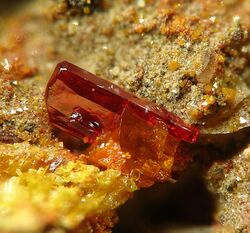| Display title | Chemistry:Phoenicochroite |
| Default sort key | Phoenicochroite |
| Page length (in bytes) | 3,190 |
| Namespace ID | 3022 |
| Namespace | Chemistry |
| Page ID | 724754 |
| Page content language | en - English |
| Page content model | wikitext |
| Indexing by robots | Allowed |
| Number of redirects to this page | 0 |
| Counted as a content page | Yes |
| Page image |  |
| HandWiki item ID | None |
| Edit | Allow all users (infinite) |
| Move | Allow all users (infinite) |
| Page creator | imported>MainAI |
| Date of page creation | 20:36, 5 February 2024 |
| Latest editor | imported>MainAI |
| Date of latest edit | 20:36, 5 February 2024 |
| Total number of edits | 1 |
| Recent number of edits (within past 90 days) | 0 |
| Recent number of distinct authors | 0 |
Description | Content |
Article description: (description)
This attribute controls the content of the description and og:description elements. | Phoenicochroite, also known as melanochroite, is a lead chromate mineral with formula Pb2OCrO4. It forms striking orange red crystals. It was first discovered in 1839 in Beryozovskoye deposit, Urals, Russia . It is named from the Greek word φοίυικος for "deep red" and χρόα for "color", in allusion to... |

